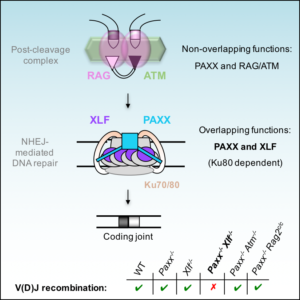Lien vers Pubmed [PMID] – 27601299
Cell Rep. 2016 Sep 13;16(11):2967-79. doi: 10.1016/j.celrep.2016.08.069. Epub 2016 Sep 2.
In Brief
Developing lymphocytes rely on nonhomologous end joining (NHEJ) to repair programmed DNA double-strand
breaks generated during antigen receptor gene assembly. Deficiency in NHEJ factors results in severe combined immunodeficiency and predisposition to cancer, thus highlighting the importance of identifying all players in this process and deciphering their functions. In this study, Chloé Lescale, Hélène Lenden Hasse, et al. show that PAXX—a component of the NHEJ machinery—has a key role in V(D)J recombination that is masked by functional redundancy with its paralog XLF.
Summary
Paralog of XRCC4 and XLF (PAXX) is a member of the XRCC4 superfamily and plays a role in nonhomologous end-joining (NHEJ), a DNA repair pathway critical for lymphocyte antigen receptor gene assembly.
Here, we find that the functions of PAXX and XLF in V(D)J recombination are masked by redundant joining activities. Thus, combined PAXX and XLF deficiency leads to an inability to join RAG-cleaved DNA ends. Additionally, we demonstrate that PAXX function in V(D)J recombination depends on its interaction with Ku. Importantly, we show that, unlike XLF, the role of PAXX during the repair of DNA breaks does not overlap with ATM and the RAG complex.
Our findings illuminate the role of PAXX in V(D)J recombination and support a model in which PAXX and XLF function during NHEJ repair of DNA breaks, whereas XLF, the RAG complex, and the ATM-dependent DNA damage response promote end joining by stabilizing DNA ends.




